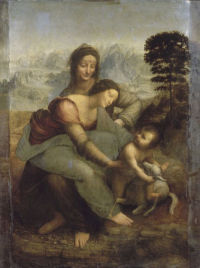Forces of Nature Click on the thumbnails to explore the trail
Read more about this trail (expand)
“Force”, the invisible agent of nature that provides all living things with motion, was a major obsession for Leonardo - the movement of turbulent water, curling hair and leaves that grow in swirling curves were all manifestations of the same natural force. In order to convey a sense of inherent energy in works of art and engineering, such phenomena must be fully understood

- Enlarge
- Zoom & explore
- Photo RMN - © Daniel Arnaudet
Madonna, Child, St Anne and a Lamb 1508-17
Leonardo devoted great effort to understanding balances and pulleys, and how they could be understood mathematically. He was also concerned with balance in the human body.
In this painting, Leonardo’s understanding of weight and balance allowed him to give perfect visual expression to a divine, abstract ideal. The Virgin is perfectly balanced on her mother’s lap whilst reaching forward to embrace her child. Christ seems more intent on playing with the lamb (a sacrificial animal and symbol of his death by crucifixion). While the Virgin’s forward momentum implies that she is about to slide off her mother’s lap, perhaps to part her child from the lamb, she is actually pivoted at the point of perfect equilibrium between stasis and movement.
The sense of balance and weight achieved in the figures of St. Anne and the Virgin is the perfect expression of the eternal harmony and stability of Christian love.
In Leonardo's words
Weight desires to act in a single line, that is, towards the centre of the world, and force an infinitude. Weight is of equal power throughout its life and force always weakens. Weight passes by nature into all its supports and exists throughout the length of these supports and completely through all their parts.
This painting is the culmination of a series of studies and versions of the same Holy family theme in drawings and cartoons by Leonardo. The composition appears to be similar to that of a cartoon (now lost but known through verbal descriptions) executed in 1501 in preparation for an altarpiece for the Giacomini Tebalducci Chapel in the church of Santissima Annunziata, Florence, which was exhibited to the public in the same church to great acclaim.
The Madonna and Child with St. Anne and St. John the Baptist, (also known as the Burlington Cartoon, National Gallery, London) represents the same family group in a variant of the same composition in what appears to be an unused cartoon drawing.
- Medium Oil on wood panel
- Size 168 x 130 cm
- Location Musée du Louvre













